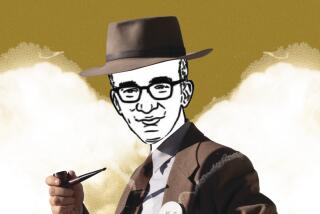Review: ‘Particle Fever’ a smashingly captivating look at a big idea
Watching a film won’t make you smarter, but if there ever was one that could, it would be “Particle Fever,” a movie so mind-bending you can almost feel your brain cells growing as you’re watching it.
As directed by Mark Levinson, a physicist turned filmmaker, with another physicist, David Kaplan, as one of the producers, “Particle Fever” is about ideas so big — What are the origins of the universe? How did matter itself get created? — that they’re hard to get your head around.
FOR THE RECORD:
“Particle Fever” review: A review of the documentary film “Particle Fever” in the March 7 Calendar section said that the Large Hadron Collider was constructed near Lucerne, Switzerland. The location is near Geneva. —
But the gift of this film is that it’s able to make these inquiries and the scientific quests that surround them not only comprehensible but unexpectedly captivating. There’s a palpable excitement around the search for knowledge, and this film captures that beautifully.
PHOTOS: Box office top 10 of 2013 | Biggest flops of 2013
“Particle Fever” is able to do all this both because it’s been shrewd in finding engaging people to talk to and because it’s been able to retain the services of Walter Murch, that most gifted of editors, to put all the footage together.
Part of the film’s excitement comes from the elegant symbiotic relationship it conveys between the theoretical physicists and the practical scientists who do actual experiments. Without the theorists, the experimenters would have nothing to try to prove, but without these practical folks the theorists would never have a clue as to whether their theories had validity.
If you have science in your background, you can probably guess what this film is about: the building by CERN, the European Organization for Nuclear Research, of the Large Hadron Collider, the biggest machine ever made by man, on a tranquil site near Lucerne, Switzerland.
The CERN project was huge in several ways. A network of some 100,000 computers spread out around the world would be used to handle the data, and 10,000 scientists from more than 100 countries worked on the project, including scientists from countries that do not get along, such as India and Pakistan, Israel and Iran.
The goal of all these people was to find the Higgs boson, sometimes called “the God particle” — a subatomic entity that physicists had theorized was the essential building block of the universe. In the decades since scientist Peter Higgs had hypothesized its existence, no one had proved that it in fact existed.
BEST MOVIES OF 2013: Turan | Sharkey | Olsen
Raising the stakes even higher was that several theoretical physicists had spent two or three decades working on a theory of the universe called the Standard Model that would likely be proved or disproved by that Large Hadron Collider experiment.
These men include affable filmmaker Kaplan; super-intense theoretical physicist Nima Arkani-Hamed, a friend and colleague described as the star of his generation; and Savas Dimopoulos, a theorist who was a mentor to the two other men.
The idea that they all might find out that their entire professional lives had been wasted weighed understandably heavily on these folks. Dimopoulos might joke that “jumping from failure to failure with undying enthusiasm is the secret of success,” but this was no laughing matter.
The practical physicists running the experiment at CERN are equally passionate and engaging, especially Monica Dunford, a young American post-doctoral student with an infectious spirit.
It’s Dunford who gives the best explanation of the CERN experiment: It’s the simplest idea, she says, the kind of thing a child would come up with. You take two things, smash them together, and analyze what happens.
What is being smashed together in this case are two protons, which will collide after being whipped up to top speeds by cruising around the collider’s 17 miles of underground tunnels. What will the result be? Will they find the Higgs boson? Will they find anything at all? Whatever happens will have profound implications for the future of physics as a science. And, as they used to say on TV, You Are There.
----------------------------
‘Particle Fever’
MPAA rating: Unrated
Running time: 1 hour, 39 minutes
Playing: Landmark’s Nuart in West Los Angeles, Edwards University Town Center 6, Irvine
More to Read
Only good movies
Get the Indie Focus newsletter, Mark Olsen's weekly guide to the world of cinema.
You may occasionally receive promotional content from the Los Angeles Times.







